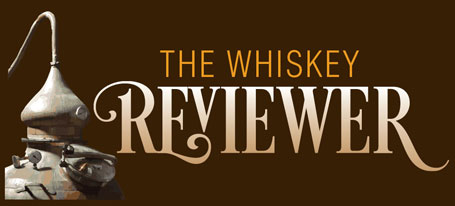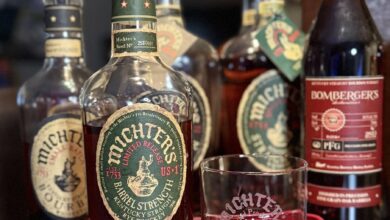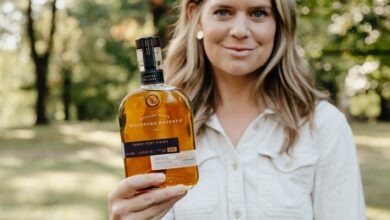Eight Best Rye Whiskeys For Under $80
By Richard Thomas

(Credit: Beam Suntory)
Since the Pandemic, some of the rules that have defined the rye whiskey market since the Rye Shortage of 2011-12 have changed. For about a decade after that crunch, which saw even a staple like Wild Turkey 101 Rye withdrawn from store shelves, the rule has been that aged and premium rye whiskey was proportionally more expensive than bourbon.
Ten years changes a lot of things, though. The shortage was caused by the trend for pre-Prohibition cocktails, very much a new thing back then, catching the industry unprepared and explosively outstripping supply. Building up stocks of mature whiskey takes several years, but the industry has had that kind of time. Expanded production from 2012 that was not tapped and bottled in the meantime is now reaching middle aged status.
Another development is the maturity of the craft whiskey sector. Seeing an opportunity, they moved into rye whiskey and played a large part in meeting the demand, and they’ve retained the share of the market thereby claimed. Their stock has also gained in maturity, with bottled in bond expressions having become a signature of craft distillers.

(Credit: Richard Thomas)
The result is that as prices for premium and super premium whiskey have climbed generally, for the rye expressions in that category things have stabilized, making a good bottle of rye whiskey more affordable (relatively speaking) than it has been in years. Here are eight bottles than any enthusiast who takes their rye seriously should have at least one of on their shelf.
Basil Hayden Malted Rye ($45)
When it was first introduced more than thirty years ago, Basil Hayden was an eight year old version of the high rye mash bill bourbon that was used by Jim Beam to make Old Granddad. They also bottled Basil Hayden at 80 proof, to make it more approachable to non-whiskey drinkers. The brand’s flagship has since lost the age statement, but the other two parts of its identity–80 proof and an association with rye–remain alive and well, and this 100% malted rye whiskey is a case in point. One of the best examples of an all-malted rye whiskey on the market, the price has actually gone down since it was first introduced two years ago. It started with an MSRP of $60, and I do not know if that official price point has changed, but many online retailers list it at $45.
Frey Ranch Bottled in Bond Rye ($63)
Nevada’s Frey Ranch prides itself as a grain-to-glass, estate distiller: they grow all the grain used in making their whiskey on their own farm. Although they are relative newcomers to being small distillers, their farming lineage goes back to the mid-19th Century. On top of that, Frey Ranch’s rye is a 100% rye mash bill, and aged for five years, one more than the minimum required by statute. That statute also requires that the whiskey come entirely from Frey Ranch, entirely from a single distilling season and be bottled at 100 proof.
High West Bottled in Bond Rye ($80)
Utah’s High West Distillery started out as an independent bottler rather than a distiller, but earned high marks with enthusiasts for being (remarkably for that time) transparent in their sourcing. They moved on to distilling as well, but High West’s own production became another part of their sourcing chain for the most part. Their brands evolved to be less reliant upon sourced whiskeys, but never moved entirely to their own production.
High West’s Bottled in Bond Rye is an exception to that model, being made entirely in-house from an 80% rye, 20% malted rye mash distillate. I’ve already detailed the requirements of the Bottled in Bond Act above for Frey Ranch’s bonded rye, but this High West example is believed to be the minimum four years of age.

(Credit: Brown-Forman)
Jack Daniel’s Single Barrel Barrel Proof Rye ($60)
When Jack Daniel’s introduced their rye mash bill, it was the first new whiskey mash used by the company since the days of Mr. Jack himself. That rye is still the major example of a Tennessee-made rye whiskey made using the Lincoln County Process (i.e. pre-maturation charcoal filtration); George Dickel’s rye doesn’t count, since it is sourced through MGP. That rye stock now appears in many iterations, especially through Jack Daniel’s series of experimental whiskeys sold only at the distillery, but the best example in general release is this one.
Knob Creek Twice Barreled Rye ($45)
The Kentucky style of rye grew up in the Bluegrass as a result of the Great Whiskey Bust of the 1970s. Many rye whiskey brands wound up under the roof of the Kentucky Majors after their original distilleries in Pennsylvania and Maryland closed. Old Overholt, a Pennsylvania classic, is one such example, and Kentucky distillers knew a lot about making bourbon, but not so much about making rye, so they made their rye as close to bourbon as possible. In Beam’s case, that meant the bare minimum of 51% rye. Both Knob Creek Rye and Old Overholt are made using that same basic stock.
Although Knob Creek 10 Year Old Rye is a close second, I prefer this version–the one given the double new oak treatment–just a little more. Some folks would zero in on the extra aging, but I think the doubling down on vanilla imparted by the second round of maturation in new oak compliments the sweeter flavor of Beam’s Kentucky style of rye well.
Masterson’s 10 Year Old Rye ($60)
This brand has seen major changes since we first wrote it up 13 years ago. The ownership changed for one thing. The California wine company that started it has since sold it to Deutsch Family Wine & Spirits. Somewhere along the line, the sourcing seems to have changed as well. It started as sourced from Alberta, Canada, but now seems to come from an undisclosed distillery in the Pacific Northwest. What remains the same is that it is well-regarded, 10 years old-plus and made from a 100% rye mash.

(Credit: Richard Thomas)
Wild Turkey Rare Breed Rye ($60)
When one considers that Wild Turkey 101 Rye is a favorite among rye diehards, arguably the best regarded of the Kentucky style rye whiskeys, it always struck me as a little strange that it took so long for the company to do a Rare Breed version of their rye whiskey. Or maybe not so strange: although Rare Breed was introduced in 1991, it was very much a creation of Jimmy Russell, and Russell was known to not be overly fond of rye whiskey. Either way, a cask strength version of the Turkey rye was a long time in coming and most welcome when it did.
Wilderness Trail Single Barrel Rye ($65)
When a company created by two industry process experts manages to grow into a mid-sized operation and become a fan favorite along the way, you know those two experts did more than the one thing right. Such was the case with Wilderness Trail. Their rye follows the Kentucky style, more or less, because of the 56% rye content of the mash. That is higher than normal, but only by a few points, and few if any are actually able to notice a margin like that. What sets this apart from the other Kentucky style ryes on the list, aside from its origins and house style, is that it is 1) a single barrel and 2) also a cask strength. But even more so, part of that Wilderness Trail house style is a low entry proof into the barrels for aging, so consequently their cask strength also comes out rather low, often in the lower or middle 50s for ABV percentage.



